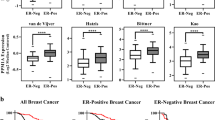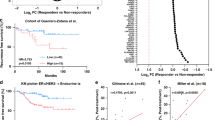Abstract
The 40S ribosomal S6 kinase 1 (S6K1) is an important regulator of cell growth. Expression of S6K1 is often elevated in breast cancer cells. However, the transcriptional mechanism of S6K1 overexpression is not understood. In this report, we demonstrate that estrogen activates expression of S6K1 via estrogen receptor (ER)α in ER-positive breast cancer cells. We also show that estrogen acts on the proximal promoter of the S6K1 gene in a mechanism involving the transcriptional factor GATA-3. Finally, we provide data that support the importance of estrogenic regulation of S6K1 expression in breast cancer cell proliferation. S6K1 directly phosphorylates and regulates ligand-independent activity of ERα, while ERα upregulates S6K1 expression. This S6K1–ERα relationship creates a positive feed-forward loop in control of breast cancer cell proliferation. Furthermore, the co-dependent association between S6K1 and ERα may be exploited in the development of targeted breast cancer therapies.
This is a preview of subscription content, access via your institution
Access options
Subscribe to this journal
Receive 50 print issues and online access
$259.00 per year
only $5.18 per issue
Buy this article
- Purchase on Springer Link
- Instant access to full article PDF
Prices may be subject to local taxes which are calculated during checkout






Similar content being viewed by others
References
Foster KG, Fingar DC . Mammalian target of rapamycin (mTOR): conducting the cellular signaling symphony. J Biol Chem 2010; 285: 14071–14077.
Fenton TR, Gout IT . Functions and regulation of the 70kDa ribosomal S6 kinases. Int J Biochem Cell Biol 2011; 43: 47–59.
Ma XM, Blenis J . Molecular mechanisms of mTOR-mediated translational control. Nat Rev Mol Cell Biol 2009; 10: 307–318.
Chung J, Kuo CJ, Crabtree GR, Blenis J . Rapamycin-FKBP specifically blocks growth-dependent activation of and signaling by the 70 kd S6 protein kinases. Cell 1992; 69: 1227–1236.
Shima H, Pende M, Chen Y, Fumagalli S, Thomas G, Kozma SC . Disruption of the p70(s6k)/p85(s6k) gene reveals a small mouse phenotype and a new functional S6 kinase. EMBO J 1998; 17: 6649–6659.
Lane HA, Fernandez A, Lamb NJ, Thomas G . p70s6k function is essential for G1 progression. Nature 1993; 363: 170–172.
Yamnik RL, Digilova A, Davis DC, Brodt ZN, Murphy CJ, Holz MK . S6 kinase 1 regulates estrogen receptor alpha in control of breast cancer cell proliferation. J Biol Chem 2009; 284: 6361–6369.
Brugge J, Hung MC, Mills GB . A new mutational AKTivation in the PI3K pathway. Cancer Cell 2007; 12: 104–107.
Barlund M, Forozan F, Kononen J, Bubendorf L, Chen Y, Bittner ML et al. Detecting activation of ribosomal protein S6 kinase by complementary DNA and tissue microarray analysis. J Natl Cancer Inst 2000; 92: 1252–1259.
Monni O, Barlund M, Mousses S, Kononen J, Sauter G, Heiskanen M et al. Comprehensive copy number and gene expression profiling of the 17q23 amplicon in human breast cancer. Proc Natl Acad Sci USA 2001; 98: 5711–5716.
Couch FJ, Wang XY, Wu GJ, Qian J, Jenkins RB, James CD . Localization of PS6K to chromosomal region 17q23 and determination of its amplification in breast cancer. Cancer Res 1999; 59: 1408–1411.
Sinclair CS, Rowley M, Naderi A, Couch FJ . The 17q23 amplicon and breast cancer. Breast Cancer Res Treat 2003; 78: 313–322.
Hu X, Stern HM, Ge L, O’Brien C, Haydu L, Honchell CD et al. Genetic alterations and oncogenic pathways associated with breast cancer subtypes. Mol Cancer Res 2009; 7: 511–522.
van der Hage JA, van den Broek LJ, Legrand C, Clahsen PC, Bosch CJ, Robanus-Maandag EC et al. Overexpression of P70 S6 kinase protein is associated with increased risk of locoregional recurrence in node-negative premenopausal early breast cancer patients. Br J Cancer 2004; 90: 1543–1550.
Early Breast Cancer Trialists’ Collaborative Group. Systemic treatment of early breast cancer by hormonal Cytotoxic or immune therapy 133 randomised trials involving 31,000 recurrences and 24,000 deaths among 75,000 women. Lancet 1992; 339: 1–15.
Ellis M . Overcoming endocrine therapy resistance by signal transduction inhibition. Oncologist 2004; 9 (Suppl 3): 20–26.
Han W, Han MR, Kang JJ, Bae JY, Lee JH, Bae YJ et al. Genomic alterations identified by array comparative genomic hybridization as prognostic markers in tamoxifen-treated estrogen receptor-positive breast cancer. BMC Cancer 2006; 6: 92.
Zhang Y, Martens JW, Yu JX, Jiang J, Sieuwerts AM, Smid M et al. Copy number alterations that predict metastatic capability of human breast cancer. Cancer Res 2009; 69: 3795–3801.
Yamnik RL, Holz MK . mTOR/S6K1 and MAPK/RSK signaling pathways coordinately regulate estrogen receptor alpha serine 167 phosphorylation. FEBS Lett 2010; 584: 124–128.
Becker MA, Ibrahim YH, Cui X, Lee AV, Yee D . The IGF pathway regulates ERalpha through a S6K1-dependent mechanism in breast cancer cells. Mol Endocrinol 2011; 25: 516–528.
Hua S, Kallen CB, Dhar R, Baquero MT, Mason CE, Russell BA et al. Genomic analysis of estrogen cascade reveals histone variant H2A.Z associated with breast cancer progression. Mol Syst Biol 2008; 4: 188.
Gruber CJ, Gruber DM, Gruber IM, Wieser F, Huber JC . Anatomy of the estrogen response element. Trends Endocrinol Metab 2004; 15: 73–78.
Sathya G, Li W, Klinge CM, Anolik JH, Hilf R, Bambara RA . Effects of multiple estrogen responsive elements, their spacing, and location on estrogen response of reporter genes. Mol Endocrinol 1997; 11: 1994–2003.
Eeckhoute J, Keeton EK, Lupien M, Krum SA, Carroll JS, Brown M . Positive cross-regulatory loop ties GATA-3 to estrogen receptor alpha expression in breast cancer. Cancer Res 2007; 67: 6477–6483.
Jiang S, Katayama H, Wang J, Li S, Hong Y, Radvanyi L et al. Estrogen-Induced Aurora Kinase-A (AURKA) gene expression is activated by GATA-3 in estrogen receptor-positive breast cancer cells. Hormones Cancer 2010; 1: 11–20.
Perou CM, Sorlie T, Eisen MB, van de Rijn M, Jeffrey SS, Rees CA et al. Molecular portraits of human breast tumours. Nature 2000; 406: 747–752.
Lacroix M, Leclercq G . About GATA3, HNF3A, and XBP1, three genes co-expressed with the oestrogen receptor-alpha gene (ESR1) in breast cancer. Mol Cell Endocrinol 2004; 219: 1–7.
Carroll JS, Meyer CA, Song J, Li W, Geistlinger TR, Eeckhoute J et al. Genome-wide analysis of estrogen receptor binding sites. Nat Genet 2006; 38: 1289–1297.
Lin CY, Vega VB, Thomsen JS, Zhang T, Kong SL, Xie M et al. Whole-genome cartography of estrogen receptor alpha binding sites. PLoS Genet 2007; 3: e87.
Bhat-Nakshatri P, Wang G, Appaiah H, Luktuke N, Carroll JS, Geistlinger TR et al. AKT alters genome-wide estrogen receptor alpha binding and impacts estrogen signaling in breast cancer. Mol Cell Biol 2008; 28: 7487–7503.
Fullwood MJ, Liu MH, Pan YF, Liu J, Xu H, Mohamed YB et al. An oestrogen-receptor-alpha-bound human chromatin interactome. Nature 2009; 462: 58–64.
Ikeda K, Inoue S . Estrogen receptors and their downstream targets in cancer. Arch Histol Cytol 2004; 67: 435–442.
Baselga J, Semiglazov V, van Dam P, Manikhas A, Bellet M, Mayordomo J et al. Phase II randomized study of neoadjuvant everolimus plus letrozole compared with placebo plus letrozole in patients with estrogen receptor-positive breast cancer. J Clin Oncol 2009; 27: 2630–2637.
Johnston SR . Are we missing the mTOR target in breast cancer? Breast Cancer Res Treat 2011; 128: 607–611.
Frizzell KM, Gamble MJ, Berrocal JG, Zhang T, Krishnakumar R, Cen Y et al. Global analysis of transcriptional regulation by poly(ADP-ribose) polymerase-1 and poly(ADP-ribose) glycohydrolase in MCF-7 human breast cancer cells. J Biol Chem 2009; 284: 33926–33938.
Acknowledgements
We thank W Lee Kraus for expression constructs and Jonathan Backer for help with kinase assays. We are especially grateful to Matthew Gamble and members of his laboratory for assistance and guidance with ChIP assays. We also like to acknowledge Antonio Di Cristofano for scientific generosity and help with animal experiments. We also thank Fannie F Seligman, Faygel Beren and Miriam Ciner for technical assistance. This work was founded by grants to MKH from NIH (CA151112), Atol Charitable Trust, Wendy Will Case Cancer Fund and Yeshiva University. TNS, ENH, ASS and HAU received support from the S Daniel Abraham Honors Program of Yeshiva University.
Author information
Authors and Affiliations
Corresponding author
Ethics declarations
Competing interests
The authors declare no conflict of interest.
Additional information
Supplementary Information accompanies the paper on the Oncogene website
Supplementary information
Rights and permissions
About this article
Cite this article
Maruani, D., Spiegel, T., Harris, E. et al. Estrogenic regulation of S6K1 expression creates a positive regulatory loop in control of breast cancer cell proliferation. Oncogene 31, 5073–5080 (2012). https://doi.org/10.1038/onc.2011.657
Received:
Revised:
Accepted:
Published:
Issue Date:
DOI: https://doi.org/10.1038/onc.2011.657
Keywords
This article is cited by
-
Beyond controlling cell size: functional analyses of S6K in tumorigenesis
Cell Death & Disease (2022)
-
Eukaryotic initiation factor 4E-binding protein as an oncogene in breast cancer
BMC Cancer (2019)
-
Estrogen-induced miR-196a elevation promotes tumor growth and metastasis via targeting SPRED1 in breast cancer
Molecular Cancer (2018)
-
Raptor localization predicts prognosis and tamoxifen response in estrogen receptor-positive breast cancer
Breast Cancer Research and Treatment (2018)
-
ERRα regulates the growth of triple-negative breast cancer cells via S6K1-dependent mechanism
Signal Transduction and Targeted Therapy (2017)



